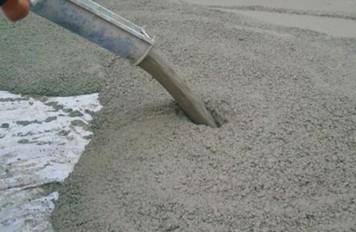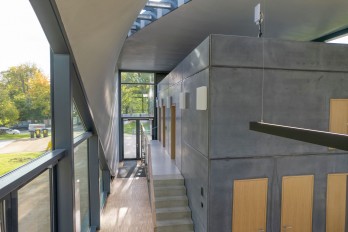Discarded plastic bottles could be used to make stronger concrete

MIT students have found a way to produce plastic-reinforced concrete that is up to 15% stronger than conventional concrete, by adding irradiated bits of plastic water bottles
MIT students have found a way to produce plastic-reinforced concrete that is up to 15% stronger than conventional concrete, by adding irradiated bits of plastic water bottles
Repurposing of plastic bottles is an optimal way of dealing with plastic waste, besides reduction of course, and way better than recycling. And what if they could be used to build more flexible concrete structures, from sidewalks and street barriers, to buildings and bridges? The research began as an undergraduate project in MIT, where scientists developed a method to fortify concrete, by adding plastic flakes –previously been exposed to small amounts of harmless gamma radiation and pulverized into a fine powder- and fly ash. The newly-discovered concrete mix is supposed to be up to 15 percent stronger than conventional concrete, while in the future, the team intends to experiment with different types of plastic, exposed to varying doses of gamma radiation, to determine their effects on concrete.
Concrete is, after water, the second most widely used material on Earth and approximately 4.5% of the world’s human-induced CO2 are generated by manufacturing concrete. By replacing small portions of concrete with plastic that would otherwise end-up in the landfill, the cement industry’s global carbon footprint would be reduced, meaning that the discovery has far-reaching implications. “Our technology takes plastic out of the landfill, locks it up in concrete, and also uses less cement to make the concrete, which makes fewer carbon dioxide emissions,†says Michael Short, an assistant professor in MIT’s Department of Nuclear Science and Engineering. The team also includes Carolyn Schaefer ’17 and MIT senior Michael Ortega, who initiated the research as a class project; Kunal Kupwade-Patil, a research scientist in the Department of Civil and Environmental Engineering; Anne White, an associate professor in the Department of Nuclear Science and Engineering; Oral Büyüköztürk, a professor in the Department of Civil and Environmental Engineering; Carmen Soriano of Argonne National Laboratory. The new paper appears in the journal Waste Management.
The team exposed various batches of flakes to either a low or a high dose of gamma rays, a radiation type that is typically used commercially to decontaminate food.“At a nano-level, this irradiated plastic affects the crystallinity of concrete,†Kupwade-Patil says. “The irradiated plastic has some reactivity, and when it mixes with Portland cement and fly ash, all three together give the magic formula, and you get stronger concrete.†“We have observed that within the parameters of our test program, the higher the irradiated dose, the higher the strength of concrete, so further research is needed to tailor the mixture and optimize the process with irradiation for the most effective results,†he also adds, concluding that “the method has the potential to achieve sustainable solutions with improved performance for both structural and nonstructural applications.â€
So far, the experiments have determined that substituting 1.5% of concrete with irradiated plastic significantly improves the mixture’s strength. While this seems a small percentage, it is enough to have a significant impact if implemented on a global scale. “Concrete produces about 4.5% of the world’s CO2 emissions,†said Short. “Take out 1.5% of that, and you’re already talking about 0.0675% of the world’s carbon dioxide emissions. That’s a huge amount of greenhouse gases in one fell swoop.â€
Source: MIT News
Want to read more like this story?

Concrete that traps CO2 emissions for good
Jul, 16, 2018 | NewsA new method to produce concrete that traps harmful CO2 emissions and increases the compression stre...

Zero-cement concrete will reduce the environmental impact in construction industry
Aug, 08, 2024 | NewsDue to the climate crisis and the high CO2 emissions of concrete, engineers and scientists are seek...
Concrete Structures
Jan, 01, 2019 | EducationConcrete structures are constructions that utilize concrete as the primary building material. Conc...

Designing a skyscraper completely made out of plastic
May, 10, 2019 | NewsArchitects Jaemin Seo and Sanghoon Park from the U.S. designed a fin-shaped skyscraper that is inspi...

This new construction system allows affordable and easy to build concrete walls of any shape, thickness and size
Aug, 08, 2017 | NewsThe company claims that about half the time or less is needed to erect a residential structure compa...

Concrete is a climate disaster and thus it’s time to clean it up
Oct, 29, 2021 | NewsFor soaring bridges, dramatic skyscrapers and even the path around your local park, builders love c...

The world’s first carbon concrete building constructed by researchers in Germany
Nov, 10, 2022 | NewsThe first building made of carbon-reinforced concrete was inaugurated in September after two and a...

Concrete - FIN EC
Oct, 19, 2023 | Software
Concrete damage based on 4 crucial factors
Feb, 01, 2024 | NewsConcrete often sustains damage due to various factors, either environmental or mechanical. In the f...
Trending

Spectacular interchanges around the world

New Release - STAAD.Pro 2024 - 2

ADINA 2025 for Structural WorkSuite

ADINA 2025 New Release!

Concrete Buildings as Rechargeable Batteries

Powerful earthquake shakes central Philippines, dozens killed


